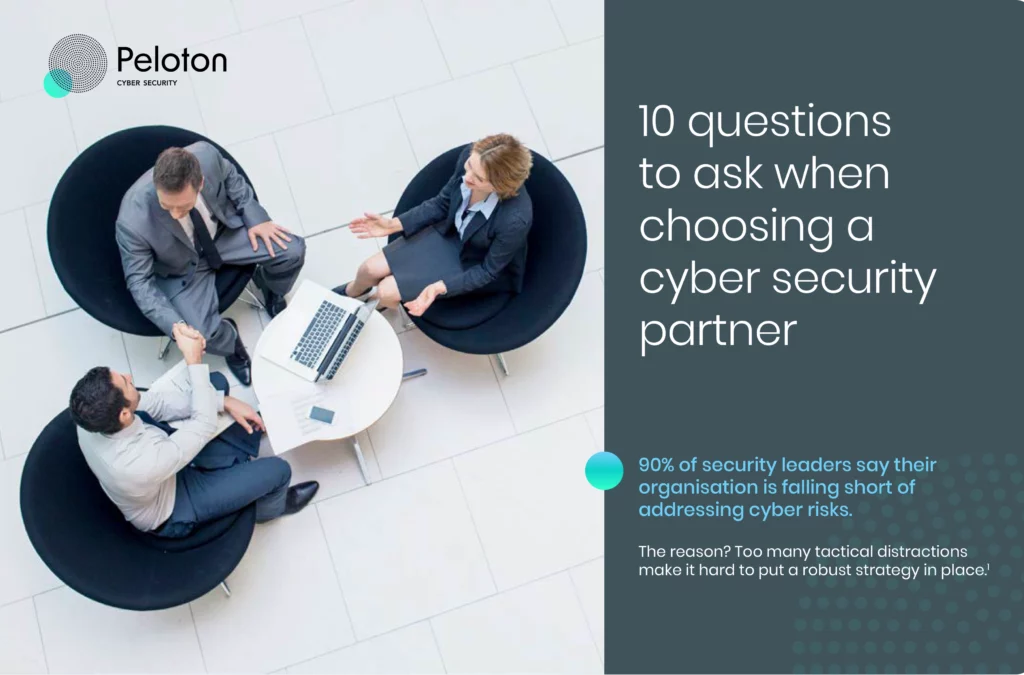Corporate IT Cyber Security
Strategic Services
Embed cyber security into the core of your business.
Helping you make better decisions about risk.
Through our comprehensive range of cyber security strategic services, Peloton can help assess your current exposure to risk, and formulate strategies to mitigate cyber security incidents.
A review of potential issues across your IT environment to uncover real threats and implement.
Identification of weaknesses that could enable actors to impersonate corporate accounts.
Finding your cyber security sweet spot.
It’s impossible to reduce your cyber risk to zero. But it’s more than possible to identify an acceptable level of risk in your business, and then put plans in place to manage it.
Our first job is to understand your most valuable assets and how they drive your competitive advantage to accelerate growth.
From here, we can develop a risk-based and threat-focused defence strategy—based on the latest intelligence and data from cyber insurers and other partners—tailored specifically to your business. It’s all about finding the sweet spot between risk and investment, and putting the right level of controls in place.
Optimal approach for risk mitigation
We use our 4-step proven process to deliver your security strategy
1. Understand your cyber risk
Our quick-start program gets you started with:
- Asset discovery
- Vulnerability assessment
- Cyber risk assessment
- Identity assessment
- ASD Essential Eight review
2. Develop a strategic plan
To address your risk, we help you build:
- Business case
- Security program defined
- Board reporting
- Defined success criteria
- Security metrics
- Risk appetite
3. Reduce your cyber risk
Execute on the strategic plan to reduce your risk with:
- Security operations (SIEM)
- Vulnerability and patch management
- Endpoint detection and response
- Supply chain risk assessment
- Network security review
- Incident response plan
- Security awareness training
4. Manage your cyber risk
Reduce your cyber risk in a sustainable way:
- Virtual CISO / security manager
- Ongoing risk management
- Internal audit
- Security metrics
- Policy development
- Threat modelling
- Business continuity
- Security hardening
- External certification

More cyber security tools can actually weaken your defence
In this guide we arm you with 10 key strategic cyber security insights and questions to ask before you pour money into any more technology, tools and services.
Find out how Peloton can help you to embed security into the core of your business.
Frequently Asked Questions
A cyber security strategy is a high-level plan that describes how an organisation will manage and mitigate risks associated with cyber threats. It provides a structured approach to understanding, managing and effectively reducing cyber risk. A cyber security strategy should align with an organisation’s business goals, technology landscape and overall risk management framework.
Mitigating cyber security incidents requires a comprehensive and layered approach. Here are some effective IT strategies to consider:
- Risk Assessment: Understand your organisation’s assets and identify potential vulnerabilities. Regularly conduct vulnerability assessments and penetration tests to find weaknesses before attackers do.
- Defence in Depth: Use multiple layers of security so that if one fails, another can stop the threat. This includes perimeter defence, internal network segmentation, endpoint security and application-level security.
- Regular Patching: Ensure all systems, software and applications are updated with the latest security patches.
- Endpoint Protection: Deploy advanced endpoint protection platforms (EPP) and endpoint detection and response (EDR) tools to detect, prevent and respond to threats.
- Multi-factor Authentication (MFA): Require multiple forms of verification, such as something you know (password), something you have (token or phone) and something you are (biometrics).
- Security Awareness Training: Educate employees about the threats they face and how to recognise potential threats like phishing emails.
- Incident Response Plan: Develop a comprehensive incident response plan and regularly review and test it. Ensure that there are clear roles and communication channels established.
- Backup and Recovery: Regularly backup critical data and ensure it can be restored quickly. Keep backups in multiple locations, including offline to protect against ransomware.
- Network Segmentation: Isolate critical assets from the main network. This can prevent an attacker from easily moving laterally within the network.
- Access Control: Implement the principle of least privilege (PoLP). Give users only the access they absolutely need and regularly review and update permissions.
- Network Monitoring and SIEM: Use Security Information and Event Management (SIEM) solutions and other network monitoring tools to continuously monitor network traffic and identify unusual patterns.
- Encryption: Encrypt sensitive data at rest and in transit to make it unreadable to unauthorised individuals.
- Secure Configuration: Harden devices by disabling unnecessary services, ports and accounts. Use industry security benchmarks as guides.
- Application Whitelisting: Only allow approved applications to run, preventing unauthorised or malicious software from executing.
- Secure Development: If developing software, follow secure coding practices and conduct regular code reviews.
- Threat Intelligence: Stay informed about the latest threats and vulnerabilities. Join industry groups or subscribe to threat intelligence feeds.
- Physical Security: Ensure server rooms and data centres have appropriate physical access controls.
- Vendor Management: Ensure third-party vendors follow proper security practices, as they can be a potential weak link in your security posture.
- Mobile Device Management (MDM): If your organisation allows BYOD (Bring Your Own Device) or uses mobile devices, implement an MDM solution to manage and secure these devices.
- Regular Audits: Periodically review and audit your security posture, making adjustments as necessary.
Implementing these strategies requires coordination between IT, security teams, and other parts of the organisation.
Always remember that security is a journey, not a destination. Peloton Cyber Security is uniquely placed to assist you on this journey.
The first step in developing an IT cyber security strategy is conducting a comprehensive risk assessment, ensuring identification of potential vulnerabilities and threats within your business that may affect execution of business strategy.







